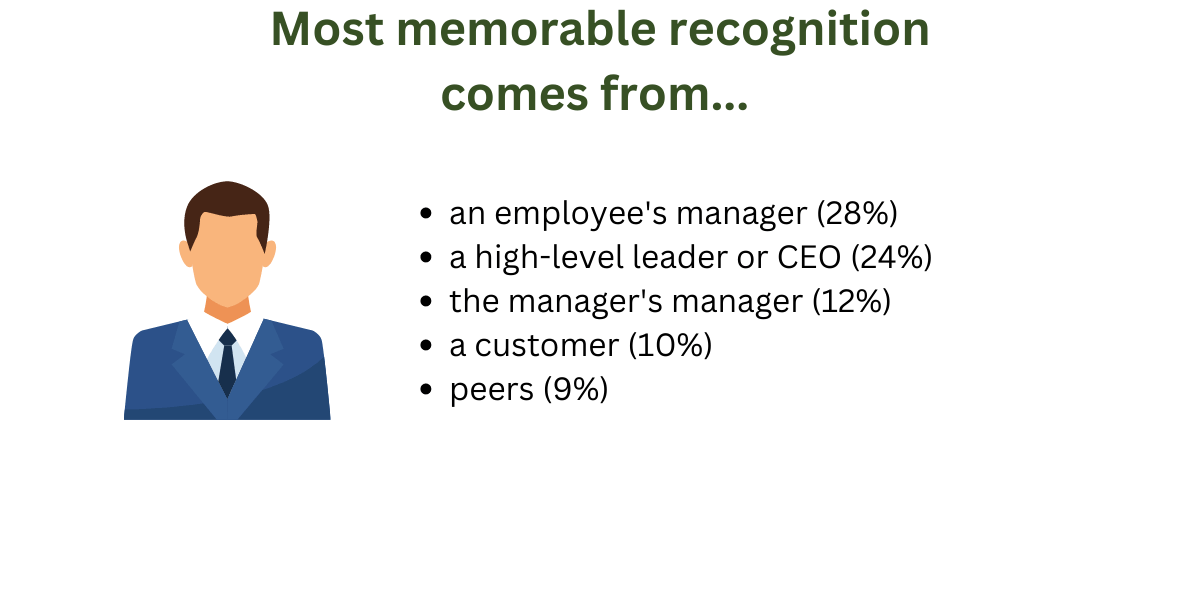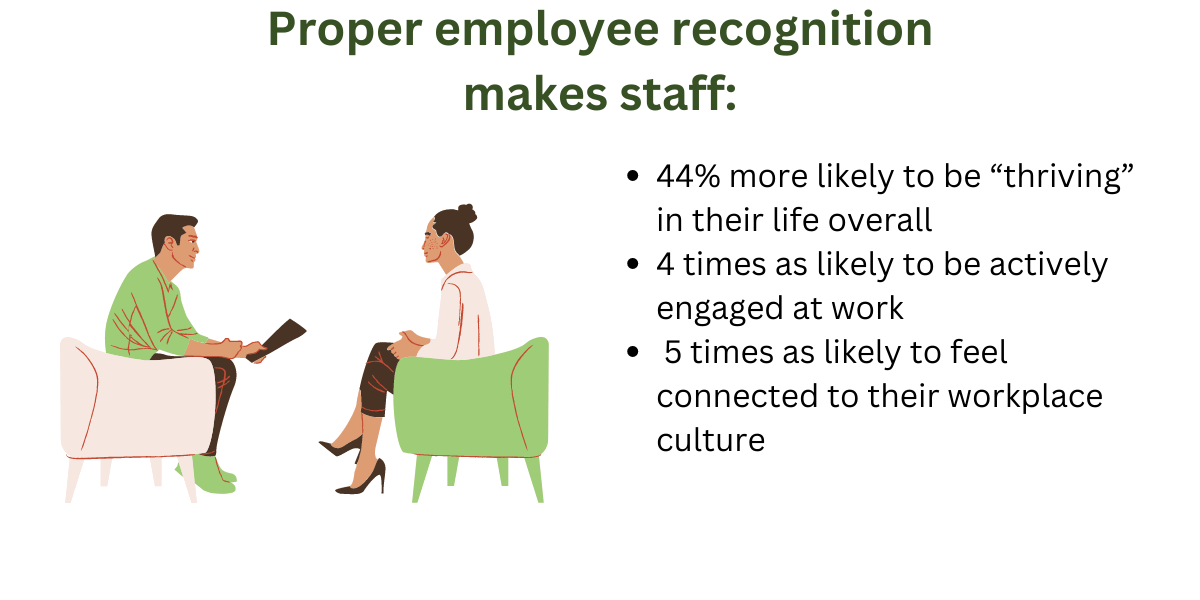Peer Recognition – The Complete Guide: Quotes, Ideas & More


by Daniela Maria Zabrautanu
August 03, 2023
In today’s competitive business world, organizations are constantly searching for ways to motivate and engage their employees. One effective method that has gained popularity in recent years is peer recognition. Peer to peer recognition is a powerful tool that allows employees to acknowledge and appreciate the efforts of their colleagues. In this guide, we will explore the meaning and importance of peer recognition, discuss different recognition ideas, and provide a step-by-step guide to implementing a successful peer recognition program. So let’s dive in and discover how peer recognition can benefit your organization and create a positive work culture. For ways of motivating and engaging staff, learn about employee incentives.
Jump to
What is Peer Recognition?
Recognition is the fuel that keeps a great team performing with excellence.
Kate Zabriskie
Peer recognition is the act of acknowledging and appreciating the achievements, contributions, and efforts of colleagues within an organization. It involves employees recognizing and praising the accomplishments of their peers, highlighting their strengths, and boosting their morale. Peer recognition is different from traditional top-down recognition, where recognition comes from managers or leaders. It empowers employees and fosters a sense of appreciation and teamwork within the workplace.
Why is Peer Recognition Important?
Peer recognition is crucial for several reasons. First and foremost, it enhances employee morale and motivation. When employees feel valued and appreciated by their peers, they are more likely to be engaged and satisfied with their work. Peer to peer recognition also helps build a positive work culture, where employees support and uplift one another. It promotes collaboration, improves teamwork, and strengthens relationships within the organization. We will explore more of its benefits later on.
- According to a survey conducted by Globoforce, 85% of companies with a peer recognition program reported a positive impact on employee engagement.
- Another study by Gallup found that employees who receive regular recognition are more likely to stay with their organization and have higher levels of productivity.
- A survey conducted by Deloitte found that organizations with a strong recognition culture have 31% lower turnover rates.
- A Society for Human Resource Management (SHRM) study found that peer recognition programs can increase employee satisfaction by up to 92%.
- According to a recent workplace study by Gallup, employees were asked to share who offered the most genuine and memorable recognition. Here are the findings:

While peer recognition is a valuable and effective tool in the workplace, it is unfortunately not as common as it should be. Many organizations still rely heavily on top-down recognition, where managers or leaders are solely responsible for recognizing their employees’ achievements.
Managers play a crucial role in setting the tone for recognition within the workplace. By actively promoting and participating in peer recognition, managers can create a culture where employees feel empowered to acknowledge and appreciate their colleagues’ hard work. They can lead by example and demonstrate the importance of recognizing and celebrating each other’s accomplishments.
By creating a recognition-driven environment, managers can empower their employees to appreciate and support one another, fostering a positive and collaborative work culture.
Related: Employee Incentive Programs: The Ultimate Guide to Retaining Top Talent
Advantages and Disadvantages of Peer Recognition
Advantages
- Increased employee engagement: Peer to peer recognition allows employees to feel valued and appreciated by their colleagues, which can lead to higher levels of engagement and job satisfaction.
- Improved teamwork and collaboration: Peer recognition encourages employees to acknowledge each other’s contributions and achievements, fostering a sense of teamwork and collaboration within the workplace.
- Enhanced morale and motivation: Being recognized by peers can boost morale and motivate employees to continue performing at their best. It creates a positive work environment where employees feel supported and encouraged.
- Increased productivity and performance: When employees feel recognized for their hard work, they are more likely to be motivated to perform at a higher level. Peer recognition can drive individuals to go above and beyond in their roles.
- Cost-effective: Peer too peer recognition programs can be implemented at a minimal cost, making it an affordable way to boost employee morale and motivation compared to traditional top-down recognition programs.
Disadvantages
- Lack of consistency: Peer recognition programs may vary in terms of implementation and frequency, leading to inconsistent recognition among employees.
- Bias and favoritism: In some cases, peer recognition may be influenced by personal relationships or biases, potentially overlooking deserving employees or creating a sense of exclusion.
- Limited impact on career growth: While peer recognition is valuable for fostering a positive work environment, it may not directly impact an employee’s career advancement opportunities for growth within the company. It is important to ensure that peer to peer recognition is complemented by other performance management and development initiatives.
Related: Reward and Recognition in the Workplace: 5 Big Distinctions
Types of Peer Recognition Ideas
Employee recognition is a crucial aspect of creating a positive and motivating work environment. It involves acknowledging and appreciating the efforts and achievements of employees. Employee recognition can take various forms, such as verbal praise, public recognition, rewards, or incentives. It plays a significant role in boosting morale, increasing job satisfaction, and improving overall employee engagement.

Source: workhuman
There are various ways to implement peer recognition within the workplace. Here are some ideas to consider:
A. Informal peer recognition
Informal peer recognition refers to spontaneous acts of appreciation and recognition among colleagues in the workplace. It is often characterized by small gestures or actions that show gratitude and acknowledgment for a job well done. Here are some informal peer recognition examples:
- Verbal praise: Encourage employees to verbally acknowledge and appreciate their colleagues’ efforts and achievements. This can be done during team meetings, one-on-one conversations, or even in passing.
- Thank-you notes: Encourage staff to write handwritten thank-you notes or send virtual messages to their colleagues to express their gratitude and recognition. These notes can be personalized and specific to the recipient’s contributions.
- Peer-to-peer compliments: Create a culture where employees feel comfortable giving compliments to their colleagues. This can be as simple as saying “great job” or “thanks” for a task well done.
- Small rewards: Consider implementing a system where employees can give small rewards or tokens of appreciation to their peers. This can include small gifts, coffee vouchers, or other personalized items.
- Public or social recognition: Provide opportunities for employees to publicly recognize their colleagues’ skills and achievements. This can be done through team meetings, company-wide emails, or a designated communication channel where employees can share success stories.
B. Formal peer recognition
Formal peer recognition is a structured expression of appreciation toward colleagues’ contributions. Here are some peer recognition examples:
- Peer nomination programs: Create a system where employees can nominate their peers for recognition based on specific criteria such as exceptional performance, talents, or innovation. The nominations can be reviewed and approved by a committee or management team, and the recognized employees can receive rewards or incentives.
- Peer to peer awards: Establish awards or recognition ceremonies where employees can nominate their colleagues for different categories such as “Employee of the Month,” “Team Player of the Year,” or “Innovator of the Quarter.” This not only highlights individual achievements but also promotes a sense of friendly competition and camaraderie among employees.
- Feedback sessions: This is a great and effective peer to peer recognition idea. Implement regular peer feedback sessions where employees can provide constructive feedback and recognition to their colleagues. This can be done through structured feedback forms or facilitated discussions. It encourages open communication and helps employees understand the impact of their work on their peers.
- Peer to peer recognition platforms: Utilize technology to create an online platform or tool where employees can easily recognize and appreciate their colleagues for doing their best. These platforms can allow for instant recognition, virtual badges or certificates, and a public recognition wall where employees can see and celebrate each other’s achievements.
- Employee spotlights: Feature employees and their achievements in internal newsletters, company blogs, or social media platforms. This not only recognizes their contributions but also raises their visibility within the organization.
C. Creative peer recognition ideas
Creative peer to peer recognition ideas can add an extra element of fun and excitement to your program. Here are a few creative peer recognition examples:
- Virtual high fives: Create a digital “high five” wall where employees can send virtual high fives to their colleagues for a job well done. This can be done through a dedicated Slack channel, email, or an internal communication tool.
- Peer appreciation notes: Encourage employees to write handwritten notes expressing their appreciation for their colleagues. These notes can be given during team meetings or left on their desks as a surprise.
- Team shout-outs: Dedicate a portion of team meetings to allow team members to give shout-outs to their colleagues who have gone above and beyond. This can boost morale and encourage a culture of recognition within the team.
- Random acts of kindness: This is one of our favorite peer to peer recognition ideas. Encourage employees to perform random acts of kindness for their colleagues. This could be bringing them a cup of coffee, offering to help with a project, or simply leaving a small gift on their desk.
- Personalized thank you gifts: Instead of generic recognition, consider giving personalized gifts that show you truly appreciate your colleagues. This could be a customized mug, a handwritten note, or a gift that aligns with their interests or hobbies.
Understanding Top-Down Recognition
Top-down recognition refers to the practice of recognition and appreciation coming from higher-level employees or management towards their subordinates. In this type of recognition, managers and supervisors play a crucial role in acknowledging and rewarding their employees’ efforts and achievements.
Top-down recognition is important because it helps foster a positive and supportive work environment. When employees receive recognition from their superiors, it shows that their hard work is valued and appreciated. This, in turn, boosts their motivation, engagement, and job satisfaction. Here are a few key points to understand about top-down recognition:
- Power dynamics: Top-down recognition highlights the hierarchical structure of an organization, where managers have authority over their subordinates. This recognition reinforces the idea that the achievements and contributions of employees are noticed and acknowledged by those in positions of power.
- Impact on organizational culture: When managers consistently recognize and appreciate their employees, it helps create a culture of recognition within the organization. This culture helps to reinforce positive behaviors, encourages teamwork, and improves overall employee morale and performance.
- Formal recognition programs: Many organizations have formal top-down recognition programs in place. These programs often include performance reviews, employee of the month/year awards, and bonuses or incentives tied to specific achievements. These formal programs provide a structured approach to recognizing and rewarding employees.
- Informal recognition: Top-down recognition can also occur informally, through simple gestures such as a verbal thank you, a pat on the back, or a handwritten note.
How top-down recognition complements peer recognition
Top-down recognition and peer recognition are both important in fostering a positive work environment and motivating employees. While peer recognition focuses on acknowledging and appreciating the efforts of colleagues at the same level, top-down recognition involves managers and supervisors recognizing and rewarding their subordinates.
Here’s how top-down recognition complements peer recognition:
- Reinforces the value of peer recognition: When employees see their managers recognizing and appreciating their hard work, it reinforces the importance of peer recognition. It sets an example for employees to do the same for their colleagues, creating a culture of mutual appreciation and support.
- Adds credibility and authority: While peer recognition is valuable, top-down recognition adds an extra layer of credibility and authority. When managers recognize an employee’s achievements, it holds more weight and can have a greater impact on motivation and job satisfaction.
- Encourages collaboration and teamwork: Top-down recognition emphasizes the importance of teamwork and collaboration. When managers recognize individuals for their contributions, it highlights the collective effort and encourages employees to work together towards common goals.
- Provides guidance and direction: Managers have a unique perspective on the organization and its goals. Through top-down recognition, they can guide employees by acknowledging specific achievements that align with the company’s objectives. This helps employees understand what is valued and reinforces behaviors and actions that benefit the organization.
- Balances power dynamics: Peer to peer recognition helps promote a sense of equality and camaraderie among colleagues. Top-down recognition, on the other hand, acknowledges the hierarchical structure within the organization. It recognizes the authority and expertise of managers and supervisors, balancing the power dynamics in the workplace. This balance is crucial for maintaining a healthy work environment where everyone feels valued and respected.
Overall, top-down recognition and peer recognition work hand in hand to create a culture of appreciation and motivation. While peer recognition focuses on celebrating the efforts of colleagues at the same level, top-down recognition adds credibility, guidance, and a sense of direction. Together, they foster collaboration, teamwork, and a positive work environment.
Incorporating both types of recognition in your organization can lead to higher employee engagement, increased job satisfaction, and improved overall productivity. It is important to create a recognition program that encompasses both peer and top-down recognition, ensuring that all employees feel valued and appreciated for their contributions.
Importance of Using a Peer Recognition Program
Benefits of implementing a peer recognition program:
- Boosts employee morale and motivation: Peer recognition programs create a positive and supportive work environment. When employees receive recognition from their peers, it boosts their morale and motivation to perform better. It also encourages a sense of camaraderie and teamwork among colleagues.
- Increases employee engagement: Peer recognition programs actively involve employees in recognizing and appreciating their colleagues’ achievements. This involvement increases employee engagement as it fosters a culture of participation and collaboration.
- Improves employee retention: When employees feel valued and appreciated by their peers, they are more likely to stay with the company. Peer recognition programs help create a sense of belonging and loyalty, reducing turnover rates and improving employee retention.
- Enhances productivity: Recognizing and celebrating achievements through peer recognition programs can enhance productivity. When employees know that their efforts will be acknowledged by their peers, they become more motivated to perform at their best and contribute to the success of the team and organization.
- Strengthens relationships: Peer recognition programs encourage employees to interact and build relationships with their colleagues. Recognizing the efforts of others fosters a sense of community and support, creating a positive work environment where relationships are strengthened.
- Promotes a culture of appreciation: Peer recognition programs help promote a culture of appreciation and gratitude. When employees are encouraged to recognize and appreciate each other’s accomplishments, it creates a positive vibe within the organization where everyone feels valued and appreciated.
Step-by-step guide to creating a peer recognition program
Creating a peer recognition program can be a valuable initiative for your organization. Here is a step-by-step guide to help you get started:
- Set clear objectives: Before you begin, define the objectives of your peer recognition program. What do you want to achieve? Whether it’s boosting morale, improving employee engagement, or enhancing teamwork, having clear objectives will guide the design and implementation of your program.
- Involve key stakeholders: Get buy-in and support from key stakeholders, such as senior leaders and department heads. Their support is crucial for the success of your program. Explain the benefits and encourage their involvement in the recognition process.
- Define criteria and guidelines: Establish clear criteria for recognition and guidelines on how to give and receive recognition. This will ensure consistency and fairness in the program. Consider factors like performance, teamwork, innovation, and going above and beyond.
- Choose a recognition platform: Decide on the platform through which your peer recognition program will be conducted. It could be a digital platform, such as dedicated software or an internal communication tool, or a more traditional approach like physical recognition boards or bulletin boards.
- Train employees: Provide training and communication to employees about the peer recognition program. Explain the purpose, guidelines, and how they can participate. Make sure they understand the value of recognition and how it can contribute to a positive work environment.
- Launch the program: Announce the launch of your peer recognition program to the entire organization. Use various communication channels to spread the word and generate excitement. Highlight the benefits and encourage employees to actively participate in recognizing their peers.
- Monitor and evaluate: Continuously monitor and evaluate the effectiveness of your peer recognition program. Collect feedback from employees and track the impact it has on morale, engagement, and teamwork. Make adjustments as needed to ensure its success.
- Celebrate success: Celebrate the success of your peer recognition program by showcasing the achievements and stories of employees who have been recognized. Recognize the top contributors and create a positive buzz around the program. This will encourage ongoing participation and inspire others to excel.
- Maintain consistency: Make sure to maintain consistency in your peer recognition program. Regularly communicate the program’s purpose, guidelines, and expectations. Recognize employees consistently and fairly to avoid any perception of favoritism.
- Continuously improve: As you gather feedback and assess the effectiveness of your program, look for areas of improvement. Stay up-to-date with best practices in peer recognition and make adjustments to your program accordingly. Keep your program fresh and engaging to sustain long-term success.
Related: Make a Reward System for Employees In-House: 5 Reasons Why+Guide
Successful Examples of Peer Recognition Programs
1. Google: Google has a peer recognition program called “G2G” (Googler-to-Googler), where employees can nominate their peers for outstanding contributions. This program has helped foster a culture of appreciation and recognition at Google, where employees feel valued for their work.
2. Cisco: Cisco has a peer recognition program called “Connections” where employees can give virtual badges to their peers to recognize their efforts and accomplishments. This program has increased employee engagement and collaboration within the organization.
3. LinkedIn: LinkedIn has a peer recognition program called “InDay” where employees can recognize their peers for their contributions and hard work. This program has not only boosted employee morale but also strengthened the sense of community within the company.
These successful examples demonstrate how peer recognition programs can have a positive impact on employee morale, engagement, and overall company culture. By implementing a similar program, organizations can create a supportive and appreciative work environment where employees feel motivated and valued.
In conclusion, peer recognition programs are a powerful tool that can help organizations foster a positive work culture, boost employee morale, and increase overall engagement. Whether through informal gestures or structured programs, recognizing and appreciating the efforts and achievements of peers can have a significant impact on employee motivation and satisfaction.
20 Peer to Peer Recognition Quotes
Looking for some quotes to add to your peer recognition notes or gift cards? Here are a few ideas:
- “Thank you for being an inspiration and making our team shine!”
- “Your dedication and hard work are truly commendable. Thank you for making a difference.”
- “I am grateful for your support and collaboration. We make a great team!”
- “Your positive attitude brightens up the workplace. Thank you for spreading joy!”
- “You’ve gone above and beyond, and your efforts don’t go unnoticed. Great job!”
- “Your creativity and innovative thinking make a significant impact on our projects.”
- “Thank you for stepping up and taking the lead. Your leadership is truly appreciated.”
- “I’m thankful to have a colleague like you – always reliable and ready to help.”
- “Your expertise is invaluable, and I’m grateful for the knowledge you share with us.”
- “Working with you is a pleasure. Your dedication is an inspiration to us all.”
- “Your commitment to excellence motivates us to be our best selves. Thank you!”
- “You make the workplace a better place with your positive energy and kindness.”
- “Thank you for your patience and understanding. You’re a great team player.”
- “Your contributions make a real difference. Thank you for going above and beyond.”
- “In a world of constant change, your consistency and reliability are truly admirable.”
- “Your support has been instrumental in my growth and success. Thank you!”
- “I appreciate your attention to detail and the quality of your work. Well done!”
- “Your positivity is contagious, and it makes the toughest days more manageable.”
- “Thank you for being a great listener and offering valuable insights. You’re a true asset to our team.”
- “Your hard work and dedication do not go unnoticed. Keep up the fantastic job!”
These quotes can serve as genuine and heartfelt ways for colleagues to recognize and uplift each other in the workplace. Encouraging a culture of peer recognition can lead to a more positive and supportive work environment.
Consider pairing these heartfelt peer-to-peer recognition quotes with a thoughtful gift card or voucher. A well-chosen gift card not only serves as a token of appreciation but also allows your recipients to indulge in something they truly enjoy.
Whether it’s for an employee anniversary, a job well done, or simply to say ‘thank you,’ a gift card with a personal touch can make a lasting impact. It allows your team members to treat themselves to something special, reminding them that their efforts are valued and celebrated.

Send yourself a gift card
Final thoughts
In conclusion, peer recognition is a powerful tool that can greatly impact employee motivation, engagement, and overall satisfaction in the workplace. By acknowledging and appreciating each other’s contributions, colleagues can create a positive and supportive work environment. Peer recognition is a simple yet impactful way to foster a culture of appreciation and support among colleagues. By recognizing and celebrating each other’s achievements, we can create a workplace environment that motivates and inspires everyone to be their best selves.



Let’s have a chat
FAQ
Peer to peer recognition is important for several reasons. Firstly, it helps to create a positive and supportive work environment. When employees feel appreciated by their peers, they are more likely to feel motivated, engaged, and satisfied with their work. Peer recognition also helps to build strong relationships and camaraderie among colleagues, fostering a sense of teamwork and collaboration.
Overall, peer to peer recognition is important because it fosters a positive work environment, enhances employee motivation and engagement, and reinforces desired behaviors and values. By implementing a peer recognition program or encouraging informal peer recognition, companies can experience numerous benefits and create a workplace culture that values and celebrates the contributions of all employees.
Unlike traditional top-down recognition, where recognition comes from managers or higher-ups, peer recognition is a grassroots approach to appreciating each other’s work within the same peer group. It fosters a culture of mutual appreciation, camaraderie, and support among team members, strengthening the bonds within the organization and promoting a positive work environment.
Peer recognition refers to the act of acknowledging and appreciating the contributions, efforts, and achievements of one’s colleagues or peers in the workplace. It involves expressing gratitude, offering compliments, and giving credit to others for their hard work and positive impact. Peer recognition can be informal, such as a simple thank-you or a verbal compliment, or it can be more formalized through peer recognition programs or platforms. The purpose of peer recognition is to foster a culture of appreciation, support, and motivation among colleagues, ultimately enhancing employee engagement and satisfaction.